Unidentified - East Pacific (Central and South America)
A place for temporarily storing messages about species from the East Pacific - Central & South America until they are identified. See Unidentified -General Page for an index of unidentified categories. Please make a point of looking through these messages to see if you can help identify any of them.
Authorship detailsRudman, W.B., 2001 (June 26) Unidentified - East Pacific (Central and South America). [In] Sea Slug Forum. Australian Museum, Sydney. Available from http://www.seaslugforum.net/find/unidentep
Related messages
Galapagos nudibranch
February 18, 2004
From: Alex Hearn
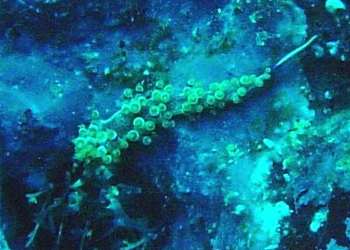
On 4th February, whilst diving at 15 m on a vertical wall (Cousins Rock, Galápagos), we came across this 3-4 cm nudibranch. Would be interested in potential ID.
Alex Hearn
ahearn@fcdarwin.org.ec
Hearn, A., 2004 (Feb 18) Galapagos nudibranch. [Message in] Sea Slug Forum. Australian Museum, Sydney. Available from http://www.seaslugforum.net/find/12193Dear Alex,
We can sometimes do the impossible, but I haven't tried miracles as yet. I suspect this is a species of Flabellina but I don't think we can see enough shape or colour to say much more.
Best wishes
Bill Rudman
Ancula? from the Galápagos Ids
February 6, 2004
From: Angel Chiriboga
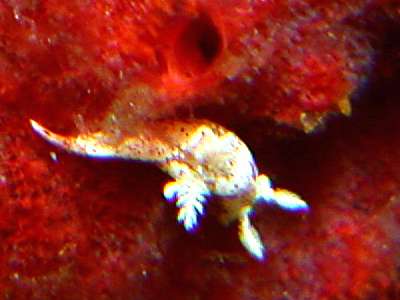
Dear Dr. Rudman,
I found this slug at Daphne Minor (25ft) near Santa Cruz Is, Galápagos Ids. But I didn't notice that it was there until I downloaded the pics on my computer. Because I was trying to take a close up picture of the sponge (possible Adocia sp.). Could you help me with the I.D (nearest possible).
Many thanks,
Angel
achiriboga@fcdarwin.org.ec
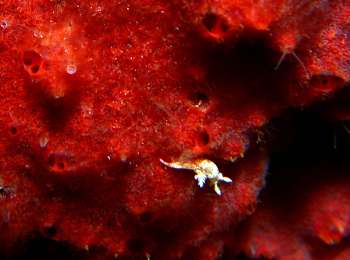
Dear Angel,
I'm afraid I can't see enough of the shape of this animal to be sure what it is. I suspect it is a member of the Goniodoridae such as Trapania or Ancula, but species of both those genera have extra-rhinophoral and extra-branchial processes, which I can't see in your photo, but they could just be obscured in your photo. The bluish 'tinge' or 'cloud' I can see over the red sponge is interesting. It looks to me like it could be a colony of Kamptozoa [Entoprocta], which often grow in associaition with sponges. Ancula gibbosa [see message 3910] feeds on kamptozoa, and many species of Trapania do as well, [see message 3767] so I would not be surprised if your animal was either a Trapania or an Ancula.
One possibility is that it is Ancula lentiginosa Farmer & Sloan, 1964, which is known from California and Baja California, Mexico. It is white with reddish brown mottling so its possible your animal is a colour form of that - but without further information we can only guess
• Farmer, W.M. & Sloan, A.J. (1964) A new opisthobranch mollusk from La Jolla, California. The Veliger, 6(3): 148-150, pl. 18.
Best wishes
Bill Rudman
Doto from British Columbia
September 13, 2003
From: Jackie Hildering and Glen Miller
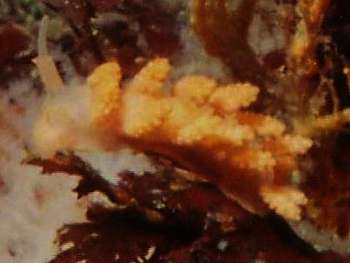
Dear Bill,
Would this be Doto columbiana? No black colouration; appears to have full orange colouration. Have seen them several times feeding on orange hydroids (Garveia annulata).
Dive: Warbonnet Wall - Plumper Group, British Columbia, Canada
Depth: 60'
Best wishes,
Jackie Hildering and Glen Miller
earthent@telus.net
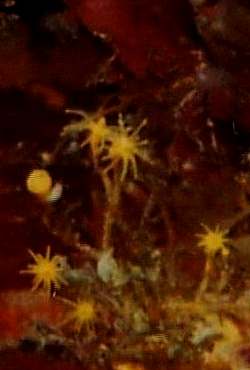
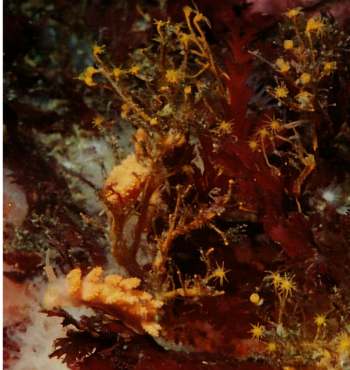
Dear Jackie and Glen,
We definitely need someone to have a look at the species of Doto in the NE Pacific. Your animal does seem to be eating the same hydroid as the animal in Marli's message, which as you'll see by the messages has been tentatively identified with Doto columbiana. But that species has much black patching on the body which seems to exclude your animal. Until we know just how variable in colour these animals are in the NE Pacific, what they eat, and a little more about their anatomy, I suspect identifying species of Doto from the region is going to cause a few problems.
Best wishes
Bill Rudman
Unknown dorid from the Galapagos Ids
September 10, 2003
From: Angel Chiriboga
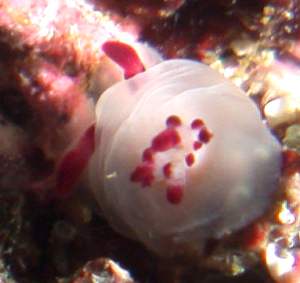
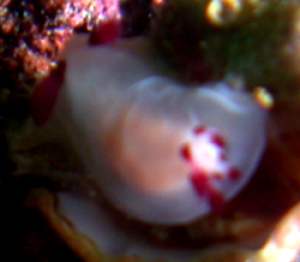
Dear Bill,
I found these slug at Las Marielas on the West side of Isabela Is., Galapagos Ids. It was at 30ft depth under a small rock.
I Hope you can help me with the ID.
Best wishes
Angel Chiriboga
achiriboga@fcdarwin.org.ec
Chiriboga, A., 2003 (Sep 10) Unknown dorid from the Galapagos Ids. [Message in] Sea Slug Forum. Australian Museum, Sydney. Available from http://www.seaslugforum.net/find/10864Dear Angel,
I don't recognise the dorid nudibranch at all. Following our apparent inability to identify your last photo, lets hope someone will recognise this one for us
Best wishes,
Bill
Dendronotus? from California
August 11, 2003
From: Chris Grossman
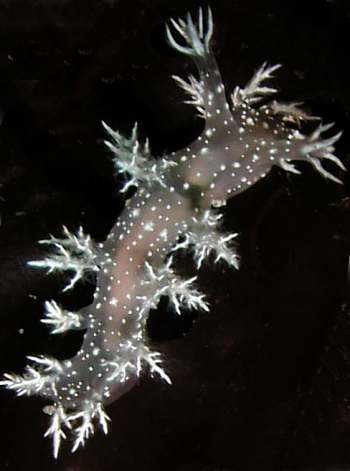
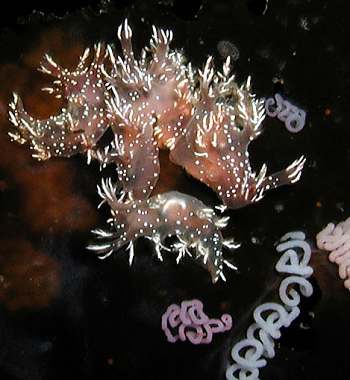
Dear Bill,
My friend Ross Overstreet [ross@diver.net] took these photos at Ship Rock, Catalina Island, California, USA in May 2003.
We have been unable to identify it, can you help?
Chris Grossman
seaslugforum.net@diver.net
Grossman, C., 2003 (Aug 11) Dendronotus? from California. [Message in] Sea Slug Forum. Australian Museum, Sydney. Available from http://www.seaslugforum.net/find/10660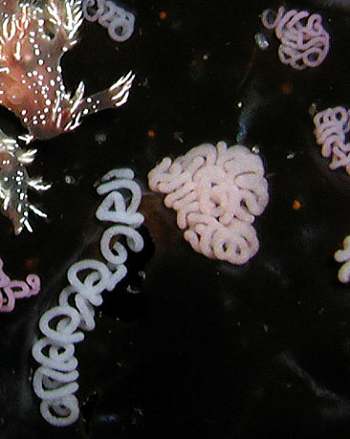
Thanks Chris & Ross,
If you have any photos showing the head end more closely - from front or underneath - it might be useful. Gordon Robilliard (1972) described a species Dendronotus albopunctatus from Washington State, and it has more lately been reported from Oregon (Behrens, 1991). Your animal fits in all the characters I can see in your photos, but of course I can't see its radular teeth. Robilliard also describes a distinct white line around the edge of the foot which I can't see in your photos. Behrens {1991} reports another species with white spots on the body as Dendronotus sp. 1. It doesn't seem to have a white edge to the foot. Both species, like yours, have no branching on the rhinophore sheath.
It is certainly an interesting find. I will look forward to an comments from local experts
Best wishes,
Bill Rudman
Sclerodoris tanya? from Panama
June 12, 2003
From: Alicia Hermosillo
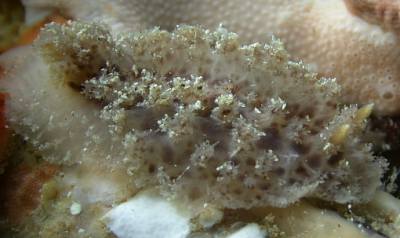
Dear Dr. Rudman,
Here is a species I found on a visit to Panama. [Pacific coast]. Can you tell what it is?
Pictures information: May 11th and 13th, 2003. Coiba National Park, Panama (Pacific Coast) 22 and 17 mm. (about 15 feet deep) I found 4 specimens altogether.
Cheers
Ali
gueri25@hotmail.com
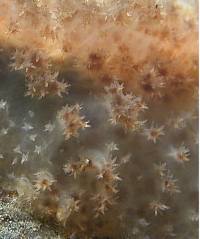
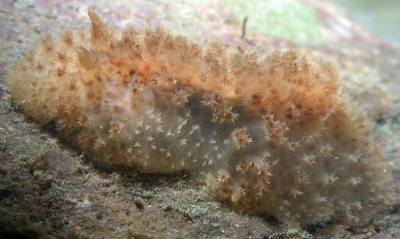
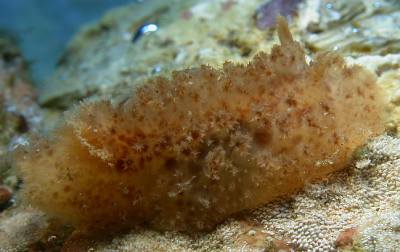
Dear Ali,
I think this is Sclerodoris tanya, but these papillate dorids are a bit tricky without local knowledge so I would be grateful for some local feedback. It also looks a bit like a species of Thordisa
Best wishes,
Bill Rudman
Costasiella from Bahia de Banderas
January 4, 2003
From: Alicia Hermosillo
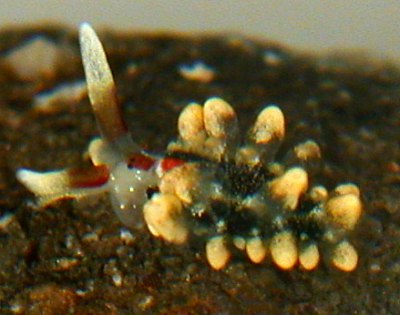
Dear Dr. Rudman,
I have been terribly busy with my thesis but I have been reading the Forum. I have an interesting critter I found last week. I saw 2 of them and they jerk pretty much like Aeolidiella alba or Limenandra nodosa. Would you know what it is?
Data: Dec 12th, 2002 Islas Marietas, Bahia de Banderas, Pacific Coast of Mexico. 5mm long, 24 feet deep.
Thanks
Ali
gueri25@hotmail.com
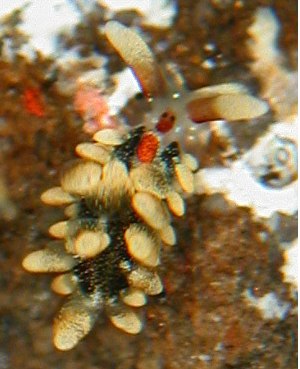
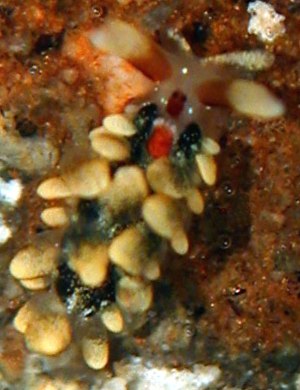
Dear Ali,
This is a species of Costasiella - see how close the eyes are together. It has a very distinctive colour pattern with the bright red pericardial hump and smaller red spot on the head so it should be easy to identify if it has been described. It has perhaps been described in Avicennia which is a journal with very limited distribution. If anyone recognises this species I would be grateful for a reference
Cheers,
Bill Rudman
Nudibranch from Peru
December 9, 2002
From: Katia
HI.
Last August I went to Punta Sal (between Tumbes and Piura, north of Perú) and saw a 25-30 mm nudibranch. It was black with little spots all over its body (yellow and orange)and had a blue-green line on the edge of its body (like it had been delineated). I found it about 7 m depth, it was swimming near some rocks.
Katia
jaimenakamura@terra.com.pe
Katia, 2002 (Dec 9) Nudibranch from Peru. [Message in] Sea Slug Forum. Australian Museum, Sydney. Available from http://www.seaslugforum.net/find/8626Dear Katia,
It is very difficult to identify animals without a photo or at least a drawing. Your animal sound very colourful so it is possibly a species of chromodorid. Two species from the east Pacific which are similar in colour are Chromodoris sphoni and Hypselodoris agassizii. Have a pook at the photos of these on the Forum and see what you think. There are two other possibilities, Hypselodoris lapislazuli and Chromodoris ruzafai, but I don't have photos of those. Perhaps someone with a knowledge of your fauna will be able to help us out
Best wishes,
Bill Rudman
Re: Aplysiid from Bahia de Banderas
September 17, 2002
From: Andrej Jaklin
Dear Alicia and Bill,
This is just my guess, but is it possible that Ali's photos are showing a juvenile Bursatella??Namely, I have seen a number of Aplysia <20mm here in the Adriatic Sea, always with smooth parapodia. Individual on Alicia's photos has prominent tubercules, which seems to start branching.
I have a picture of alive Bursatella, taken in acquarium, but this animal was fully grown, over 15cm in length.
Regards,
Andrej
jaklin@cim.irb.hr
Jaklin, A., 2002 (Sep 17) Re: Aplysiid from Bahia de Banderas. [Message in] Sea Slug Forum. Australian Museum, Sydney. Available from http://www.seaslugforum.net/find/7968Dear Andrej,
Anything's possible, that's why I suggested the only way to be sure is to follow some animals as they grow. Certainly Aplysia parvula can have tubercles or 'bumps' on the parapodia but I don't know whether other juveniles do something similar.
Best wishes,
Bill Rudman
Nudibranch ID help
July 9, 2002
From: Edgar Valencia-Morales
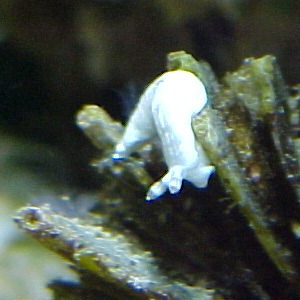
Dear Sirs
I live in Mexico, and I have a 450 liters tank. Last saturday I found this guy crawling in my tank. I sent a picture to reefcentral (I'm sending you 3) and Dr Ron Shimek told me it should be a dorid nudibranch and he also told me to contact this forum hoping you can give me more info about him.
His size is 1.5 cms, and this guys should've been in my tank for at least 8 months, since I haven't introduced new live rock or corals in which he might have arrived. I have no idea about what he could've been eating all this time. Dr Shimek told me he might eat sponges, Bryozoans or tunicates. I think sponges might be the best choice cause I have some encrusting sponges and have not seen either tunicates or bryozoans in my tank.
Hope you can help me
Best regards
Edgar
edgar@cifn.unam.mx
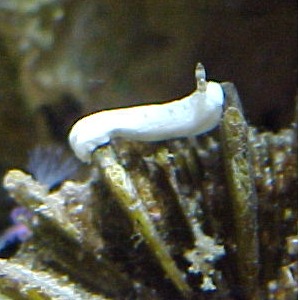
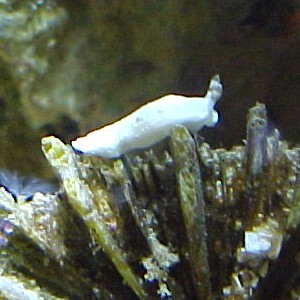
Dear Edgar,
Your animal is an arminid, almost certainly a species of Dermatobranchus. If you go to the Species List you will find a variety of species of Dermatobranchus and Armina to give you an idea of their shape and biology. As far as we know species of Dermatobranchus feed on soft corals. It is possible there are/were some small soft coral colonies hidden in your 'live rock'.
Best wishes,
Bill Rudman
Easter Island acteonid
May 17, 2002
From: Bret Raines
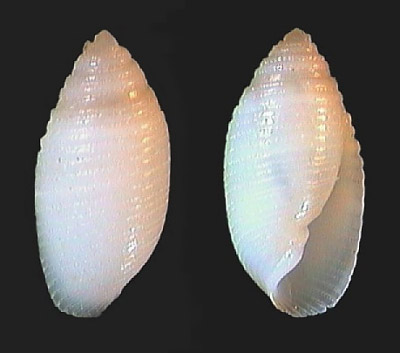
Hello Bill,
During a trip to Easter Island in March 1998, I found this tiny acteonid. I have been unable to ID it, but that's no surprise since my area is Pectinidae. It was actually live taken, but was only discovered later when sorting through mud dredged at 80 meters. Sorry about the image quality.
7mm shell length
Thank you in advance for your time.
Sincerely,
Bret Raines
rainesbk@cybertime.net
Raines, B., 2002 (May 17) Easter Island acteonid. [Message in] Sea Slug Forum. Australian Museum, Sydney. Available from http://www.seaslugforum.net/find/4950Dear Bret,
I am afraid I can't really help except to agree its an acteonid.
Best wishes,
Bill Rudman.
Another Easter Is. bubble-shell
May 17, 2002
From: Bret Raines
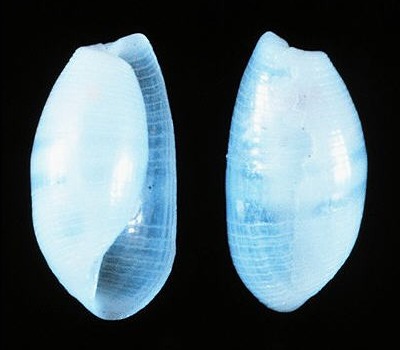
Bill,
This little bubble was sorted out of shell grit collected from 10 meters of water. Anakena Beach, Easter Island. March, 1998.
Thanks again,
Bret Raines
rainesbk@cybertime.net
Raines, B., 2002 (May 17) Another Easter Is. bubble-shell. [Message in] Sea Slug Forum. Australian Museum, Sydney. Available from http://www.seaslugforum.net/find/4951Dear Bret,
I'm afraid I can't be much help with these empty bubble shells. It is possibly a species of Atys but again we need some anatomical information.
Best wishes,
Bill Rudman.
Pupa sp. from Easter Island
May 17, 2002
From: Bret Raines
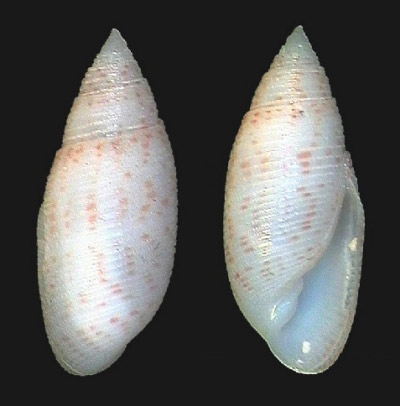
Dear Bill,
Here is another acteonid from Easter Island.
Shell length: 8mm. Dredged at 30-50m in fine sand, off the western coastline near Tahai, Easter Island. March 1998.
Sincerely,
Bret
rainesbk@cybertime.net
Raines, B. , 2002 (May 17) Pupa sp. from Easter Island. [Message in] Sea Slug Forum. Australian Museum, Sydney. Available from http://www.seaslugforum.net/find/6240Dear Bret,
From the shape of the shell I guess this is a species of Pupa. Perhaps someone with a conchological inclination will recognise it.
Best wishes,
Bill Rudman
Easter Island bubble-shell
May 17, 2002
From: Bret Raines
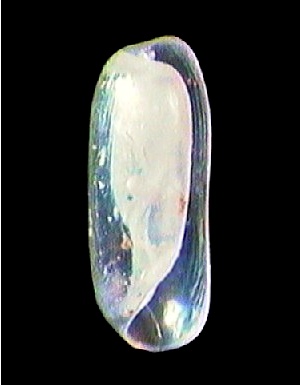
Hello Bill,
I would welcome some help in identifying this cephalaspidean from Easter Island.
Dredged at 30-50m in fine sand, off the western coastline near Tahai, Easter Island. Shell length: 2mm
Sincerely,
Bret Raines
rainesbk@cybertime.net
Raines, B. , 2002 (May 17) Easter Island bubble-shell. [Message in] Sea Slug Forum. Australian Museum, Sydney. Available from http://www.seaslugforum.net/find/6242Dear Bret,
Unfortunately this shell shape seems to have evolved a number of times amongst the cephalaspideans. Apart from suggesting it may be a Cylichna or Retusa, I'm afraid we would need some anatomical information to decide what family it belongs to.
Best wishes,
Bill Rudman
Aeolid # 2 from Bahia de Banderas
April 27, 2002
From: Alicia Hermosillo
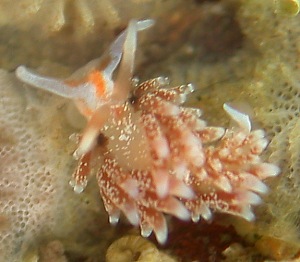
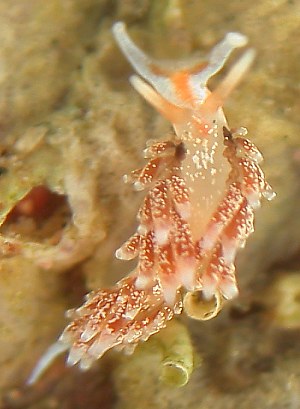
Dear Dr. Rudman,
Here is another one of the aeolids I need to identify, this one is also from Playa Mismaloya, Bahia de Banderas, Pacific Coast of Mexico, on April 6th. I found it 38 feet deep. It was 5 mm long.
Thanks for taking a look at it.
Ali
gueri25@hotmail.com
Hermosillo, A., 2002 (Apr 27) Aeolid # 2 from Bahia de Banderas. [Message in] Sea Slug Forum. Australian Museum, Sydney. Available from http://www.seaslugforum.net/find/6754Dear Ali,
At 5 mm, it is most probably a juvenile. Its shape suggests a glaucid of some sort. Two interesting features are the orange markings in the midline and the hint of a swelling or lamella on the right rhinophore in the upper photo. Both would fit Hermissenda crassicornis but we will need someone with knowledge of juveniles to help us.
Best wishes,
Bill Rudman
Aeolid # 3 fom Bahia de Banderas
April 27, 2002
From: Alicia Hermosillo
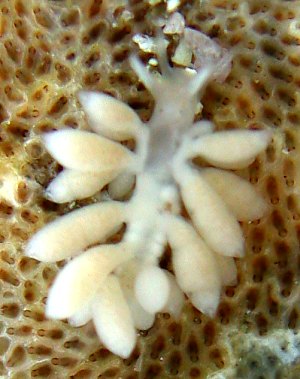
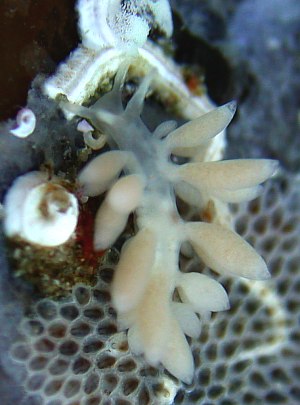
Dear Dr. Rudman,
This aeolid I found at Los Arcos, Bahia de Banderas, Pacific Coast of Mexico, 27 feet deep on April 14th. This 6 mm long specimen was under a rock with 4 other smaller ones (4, 3, 3, and 3 mm long).
Again, thanks for taking a look at it.
Ali
gueri25@hotmail.com
Hermosillo, A., 2002 (Apr 27) Aeolid # 3 fom Bahia de Banderas. [Message in] Sea Slug Forum. Australian Museum, Sydney. Available from http://www.seaslugforum.net/find/6755Dear Ali,
You are probably one of the first people to look for and photograph such small nudibranchs in your part of the world. I suspect this is an adult and its either a species of Eubranchus or Cuthona. Not much help I'm afraid but I suspect you will need to have a look at its radula to be sure.
Best wishes,
Bill Rudman
